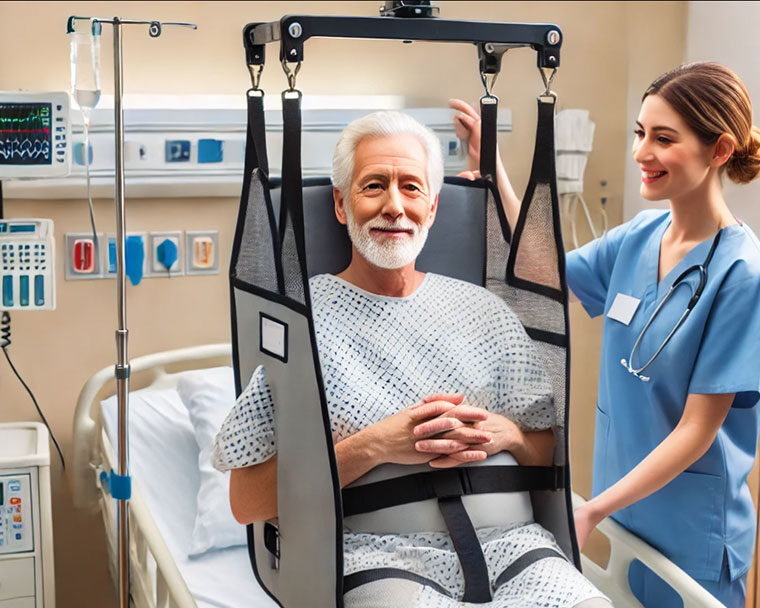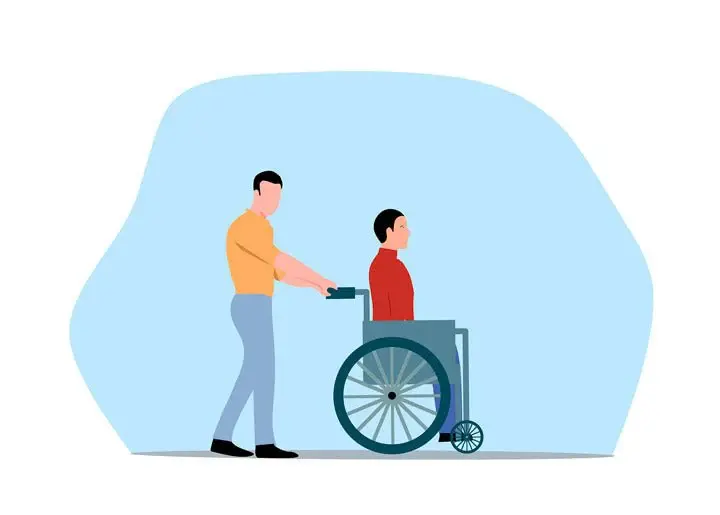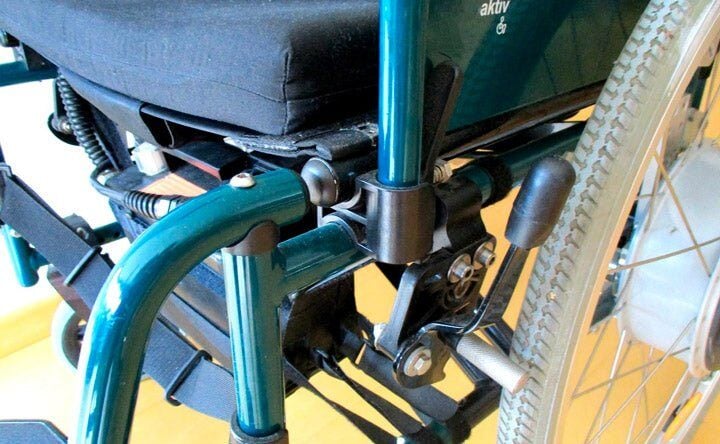Buyer's Guide to Standing Patient Lifts / Hoyer Lifts – USA

Standing patient lifts, commonly referred to as Hoyer lifts, are essential mechanical devices designed to assist individuals with limited mobility in safely transitioning between positions, such as from a bed to a chair or from a toilet to a wheelchair. These lifts play a critical role in reducing strain on caregivers while ensuring patient safety and comfort.
Introduction
Despite the widespread availability of patient lift equipment in hospitals, studies show that equipment is only used in 21% of patient transfers, with the most common transitions being bed-to-toilet (21%) and toilet-to-bed (18%). Factors such as patient weight, mobility limitations, and availability of staff and equipment strongly influence usage. Notably, lower mobility scores and physical or mental impairments double the likelihood of using a lift.
For male patients, who generally have a higher body mass, the risk of falls and caregiver injuries (e.g., low back pain and musculoskeletal injuries) is even greater. Meta-analyses confirm that mechanical lifts significantly reduce musculoskeletal injury rates (g = 1.11, 95% CI 0.914–1.299) and provide a favorable cost-benefit ratio (1.2 to 3.29), making them a valuable investment for both healthcare facilities and home use.
Who Needs a Standing Patient Lift?
Standing patient lifts are essential for individuals with severe mobility limitations, including those recovering from stroke, spinal cord injuries, muscle weakness, and post-surgical conditions. These devices provide a safe and controlled way to transfer patients, reducing strain on caregivers and minimizing the risk of falls.
For male patients, who typically have a higher body mass, the need for mechanical lifting is even more critical. Studies indicate that lifts are used in only 21% of transfers, despite their ability to reduce musculoskeletal injuries among caregivers. When compared to manual lifting, mechanical devices like Hoyer lifts improve safety and comfort by minimizing patient anxiety and reducing the physical burden on healthcare providers.
Caregivers, including family members, benefit significantly from using Hoyer lifts. Research shows that mechanical lifts can be operated by a single nursing assistant, whereas manual transfers often require two caregivers. Additionally, patients report fewer fear-based reactions and discomfort when using a lift compared to manual methods. By incorporating standing patient lifts into daily care routines, both patients and caregivers experience greater ease, reduced injury risk, and improved overall well-being.
Types of Standing Patient Lifts
Sit-to-Stand Lifts
Sit-to-stand lifts, also known as Sara Lifts, Lift Ups, Stand Assist, or Stand-Up Lifts, are designed for patients who can bear some weight but lack the strength to transition from sitting to standing independently. These lifts provide support to the upper body and legs, helping patients rise safely without excessive strain on caregivers. Sit-to-stand lifts come in both mechanized and non-mechanized versions. Mechanized models use electric or hydraulic systems to provide smooth lifting, while non-mechanized versions require some physical effort from the caregiver. These patient lifts are particularly beneficial for post-surgical recovery, stroke rehabilitation, and conditions that cause muscle weakness.

Source: https://www.ncbi.nlm.nih.gov/books/NBK591828/
Mechanical Lifts
Mechanical lifts, often hydraulic or electric-powered, are used for patients who cannot bear weight or assist in movement due to medical conditions such as spinal cord injuries or severe muscle atrophy. These lifts use a sling system to transfer patients safely between surfaces, such as from a bed to a wheelchair. They can be portable or installed as ceiling-mounted systems, offering flexibility based on the patient’s needs. Studies show that mechanical lifts reduce caregiver injuries and improve patient safety compared to manual lifting techniques.

Manual Lifts
Manual lifts rely on a caregiver’s strength to operate, making them more physically demanding. While they are cost-effective and require no power source, they can increase the risk of musculoskeletal injuries for caregivers. Compared to sit-to-stand and mechanical lifts, manual lifts offer less stability and are often used in emergency situations or when other lift types are unavailable.
Barriers and Facilitators for the Use of Hoyer Lifts by Healthcare Workers: A Scoping Review
Hospitals rank among the most hazardous workplaces, with nursing staff particularly vulnerable to ergonomic hazards due to patient handling and repetitive tasks. Work-related musculoskeletal disorders (MSDs), including back and neck pain, are prevalent among nurses and nursing assistants, often leading to injuries. The Occupational Safety and Health Administration (OSHA) advocates for minimizing manual patient lifting through Safe Patient Handling and Mobility (SPHM) programs, which integrate engineering, administrative, and behavioral controls. Despite strong evidence supporting the benefits of SPHM, the utilization of patient lifts remains suboptimal.
This scoping review identified key barriers and facilitators influencing the use of patient lifts by healthcare workers.
Organizational factors, such as leadership support, standardized risk assessments, and adequate training, emerged as significant facilitators, while staff shortages, high workloads, and lack of program ownership posed notable barriers.
Accessibility and availability of lifting equipment were also critical determinants, affecting timely utilization in patient care settings. Challenges related to equipment maintenance, storage inaccessibility, and time constraints further limited lift use.
Cultural and behavioral influences played a substantial role in shaping healthcare workers’ attitudes toward lift use. The presence of a strong safety culture and injury risk awareness facilitated adoption, whereas peer pressure, resistance to change, and occupational socialization acted as barriers.
Many workers adhered to the perception that injuries are an inherent part of their job, deterring safe handling practices. Additionally, some viewed lift use as conflicting with patient-first care principles, further limiting its implementation. Reluctance to challenge physicians’ requests and concerns about patient dignity also contributed to underutilization.
Patient-related factors further influenced adoption, as some patients preferred not to use lifting devices due to fear, anxiety, or dignity concerns. Weight limitations, lines and tubes, and urgent care needs sometimes made manual handling the more immediate choice. Additionally, healthcare workers' own lack of skills, competency, or negative perceptions of the devices played a role in resistance to lift adoption.
The findings highlight the need for comprehensive interventions, including participatory ergonomics, investment in hospital infrastructure, and the promotion of a safety-oriented workplace culture.
Tips for Safe Usage and Maintenance of Standing Patient Lifts for Patients with Urinary Incontinence
Using a standing lift correctly is crucial to ensuring patient safety, especially for those with urinary incontinence. Follow these steps for proper usage:
- Prepare the Patient – Ensure the patient is wearing an absorbent wrap or pad, such as QuickChange Wrap, to prevent leaks during transfer.
- Position the Lift – Place the lift close to the patient and lock the wheels.
- Secure the Sling – Attach the appropriate sling, ensuring it supports the patient’s weight and allows for comfort.
- Engage the Patient Lift – Slowly raise the patient, monitoring their posture and stability.
- Transfer Safely – Move the patient to their destination while keeping movements smooth and controlled.
Common Mistakes to Avoid
- Incorrect Sling Size – Using an ill-fitting sling can cause instability.
- Rushing the Process – Quick movements increase the risk of falls.
- Ignoring Incontinence Needs – Failing to check or change absorbent products before transfer can cause discomfort and hygiene issues.
Routine Maintenance Tips
- Inspect for Wear and Tear – Regularly check slings and mechanical parts.
- Keep Lifts Clean – Sanitize after each use, especially when handling incontinent patients.
- Ensure Proper Charging – Keep battery-operated lifts fully charged to avoid malfunctions.
Conclusion
Standing patient lifts, such as Hoyer lifts, play a crucial role in ensuring safe and comfortable transfers for individuals with limited mobility. These devices not only reduce the risk of falls and injuries for patients but also alleviate strain on caregivers, making them essential for home and healthcare settings. However, for patients with urinary incontinence, using the right absorbent products is equally important to maintain hygiene and prevent leaks during transfers.
QuickChange Wraps offer an effective solution by providing superior absorbency and ease of use, ensuring both patient comfort and caregiver convenience. Whether transitioning from bed to wheelchair or toilet to chair, integrating QuickChange Wraps into daily care routines enhances dignity and simplifies incontinence management.
For those seeking support, we invite you to purchase a 10 Count Trial Pack here or request a professional-use sample pack for healthcare institutions here.
References:
- Gingher, M. C., Karuza, J., Skulski, M. D., & Katz, P. (1996). Effectiveness of lift systems for long-term care residents. Physical & Occupational Therapy in Geriatrics, 14(2), 1–11. https://doi.org/10.1080/J148v14n02_01
- Khairallah, G. M., Mowafi, H., Al-Hajj, S., Brackett, A., & Sakr, C. J. (2024). Barriers and facilitators for the use of patient lifts by healthcare workers: A scoping review. International Journal of Environmental Research and Public Health, 21(12), 1659. https://doi.org/10.3390/ijerph21121659
- Kucera, K. L., Schoenfisch, A. L., McIlvaine, J., Becherer, L., James, T., Yeung, Y. L., Avent, S., & Lipscomb, H. J. (2019). Factors associated with lift equipment use during patient lifts and transfers by hospital nurses and nursing care assistants: A prospective observational cohort study. International Journal of Nursing Studies, 91, 35-46. https://doi.org/10.1016/j.ijnurstu.2018.11.006
- Lee, M. P., et al. (2016). Fundamentals of Total Worker Health approaches: Essential elements for advancing worker safety, health, and well-being.
- Open Resources for Nursing (Open RN); Ernstmeyer, K., & Christman, E. (Eds.). (2021). Nursing fundamentals [Internet]. Eau Claire (WI): Chippewa Valley Technical College. Chapter 13 Mobility. Available from: https://www.ncbi.nlm.nih.gov/books/NBK591828/
- Patient lifts. (1990). Health Devices, 19(3), 67-96. PMID: 2372319.
- QuickChange. (n.d.). QuickChange Incontinence Wraps. [Website]. Retrieved February 8, 2025, from https://quickchange.com/
- Richarz, H. U., Tamayo, A., Rahmig, J., Siepmann, T., & Barlinn, J. (2023). The impact of mechanical devices for lifting and transferring of patients on low back pain and musculoskeletal injuries in healthcare personnel—A systematic review and meta-analysis. Journal of Occupational Health, 65(1), e12423. https://doi.org/10.1002/1348-9585.12423

